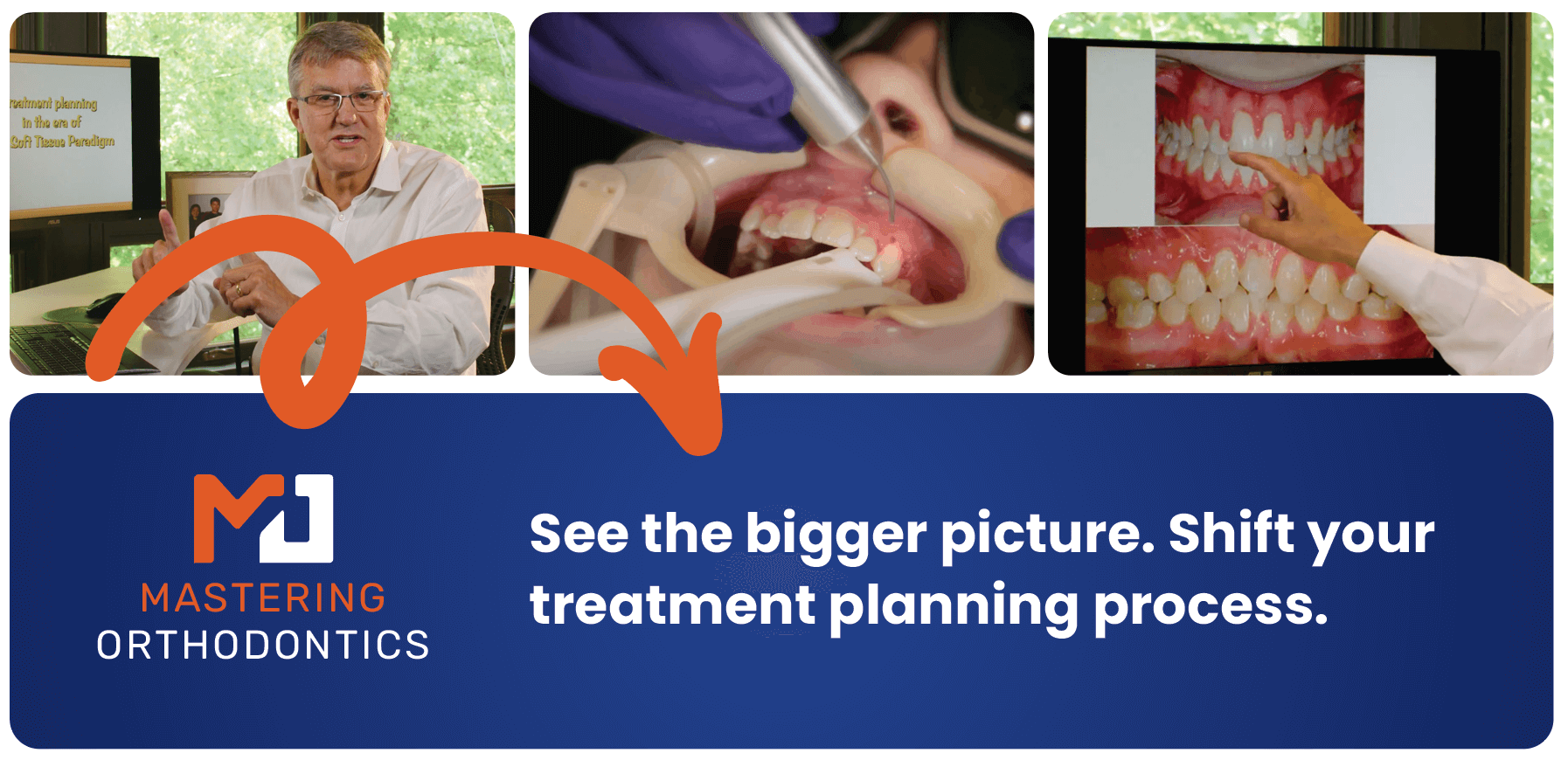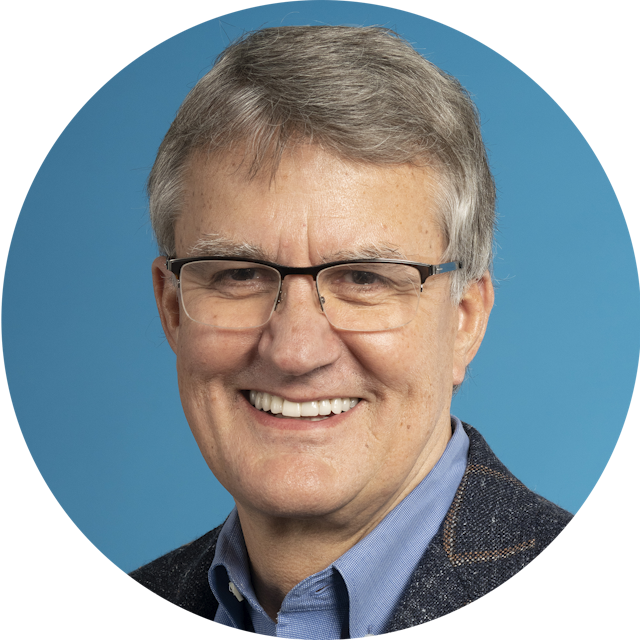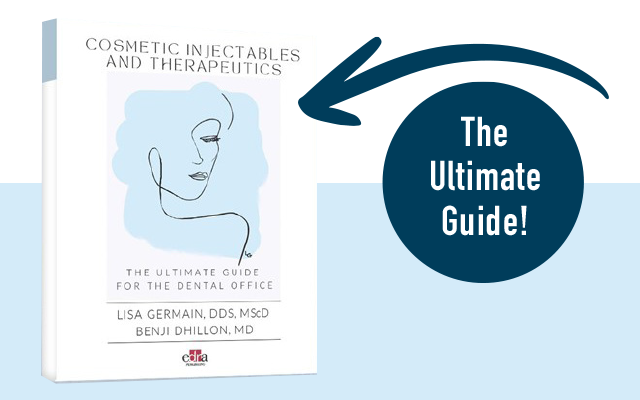See the Bigger Picture
For over 15 years, Orthodontist Dr. David Sarver taught clinicians his unique approach to treatment, opening his yearly course to 30 orthodontists. He’s also written numerous textbooks on the subject and has lectured all over the world, educating clinicians about the importance of considering the full face rather than just moving teeth when developing a treatment plan.
But even with all these efforts, it seemed like he wasn’t reaching enough clinicians with his message. Patients were still coming to his office as adults after braces or aligners didn’t solve their problem, because the clinician who treated them just wasn’t trained in the art of full-face esthetics. It was clear to Dr. Sarver he needed to expand his audience, and that’s why he decided to create Mastering Orthodontics. The online learning platform launched in January, featuring over 20 case-based courses.

Through Mastering Orthodontics, Dr. Sarver now reaches dentists and orthodontists anywhere in the world, making it easy for them to watch the modules on their own time and at their own pace. Young dentists who might not be inclined to pick up a textbook now can take in his teachings in their preferred form, and use what they learn to create more esthetic results for their patients.
The idea is for clinicians to feel like they’re sitting with Dr. Sarver as he plans a treatment, not just listening to a talking head go over PowerPoint slides. With each case he breaks down esthetic treatment into three areas: macroesthetics, miniesthetics and microesthetics, which encompass the facial appearance, the smile and the teeth themselves.
He teaches dentists to go beyond just looking at problems with the teeth and to instead look at the dentofacial complex. This means considering how changing the smile might alter the face and what other treatment, such as rhinoplasty, patients might need to truly get the results they’re after.
The interdisciplinary approach Dr. Sarver takes to orthodontics can get quite complicated, but to make it more repeatable and teachable, he has systematized the workflow of diagnosing the problems patients present and establishing treatment goals. Treatment becomes more personalized with this method, and instead of just getting straighter teeth, patients experience true transformations they didn’t know were possible.
The goal of his teachings is simple. Dr. Sarver wants clinicians to see the face.
“All the dentists I work with, they get it because they’re with me all the time. The minute a new patient walks into the room they see a face, they see a smile, and then they see teeth,” he said. “They don’t immediately go to the teeth and say ‘you have a cavity’ and miss all the other opportunities.”
Bridging The Gap
When Dr. Sarver first arrived in Birmingham, where he still lives and practices today, he took on a teaching position at the University of Alabama. The vice president of health affairs who hired him had been a dean at the University of North Carolina, where Dr. Sarver went to dental school. The oral maxillofacial surgeon knew the kind of training Dr. Sarver received from trailblazers like Drs. William Proffitt, Ray White, Timothy Turvey and Bill Terry, and that he would be the perfect person to bridge the gap between the oral surgery and orthodontics departments.
“I was the liaison and my job was to see patients with dentofacial deformities, come up with their combined orthodontics and surgical plan and then execute,” Dr. Sarver said. “And what I began to notice right away was most of those patients, virtually all of them, had been through a few sets of braces, veneers, crowns, you name it, all with negative outcomes. That’s because the problem wasn’t the teeth. It was the skeleton and that wasn’t being addressed.”
Early in his career, Dr. Sarver saw what not to do, and that forced him to think creatively. One of the oral maxillofacial surgeons Dr. Sarver helped teach while in residency, Dr. Louis Costa, went on to become a facial plastic surgeon and came back to work with him one day a week in the university clinic. Dr. Costa showed him that dentists tended to concentrate on hard tissue without considering the soft tissue and why that was a problem. Through him, he learned how to approach treatment by looking at the full face.
Going Beyond Before And Afters
Dr. Sarver was seeing adults in his practice who had been treated 25 years ago with the old way of thinking, and that bothered him. They came to him because their bite still wasn’t right or they didn’t like their appearance. Many needed jaw surgery. He was also seeing a lot of teenagers who needed work beyond just moving teeth, and he knew he had to do something different.
“As my adolescent practice grew, I became interested in how the face changes with age,” Dr. Sarver said. “I decided to make the commitment then to follow patients as long as I could and to document their individual cases as long as possible. I also researched data on how both the soft tissue and skeletal components of the craniofacial complex changed with time.”
This idea would lead him to create video morphographies that show patients’ progress over decades, what Dr. Sarver has become known for. A 14-year-old patient “really kicked off the whole thing,” with Dr. Sarver “breaking all the rules that were the accepted standards” with that initial case.
Because of the research he’d done, he knew how her face would change over time, impacting his treatment recommendations, and he wanted to document the evolution. Every five years, he takes records of this patient, who has since moved to Atlanta, and has done so now for 35 years. Through the photographs, you can watch where she started and where she is now, and you can see the soft tissue impacts of aging. He now does this with every patient.
______________________________________________
In 2006, he began appearing on programs such as The Today Show to talk about his treatment approach and knew before and after photos wouldn’t make the impact he wanted. A few of his patients worked at a technology center in town and volunteered to create a solution that would overlay the sequential photographs—demonstrating dynamically not only the immediate movements, but the changes that occurred since treatment. He describes these morphographies as “by far the most powerful teaching tool I have seen in our profession.”
“Knowing the data, I expect facial characteristic to change this way if you’re a female and this way if you’re a male,” he said, “and it’s my job to know that and to plan your treatment appropriately.”
And even though he’s received criticism from other orthodontists over the years about his approach being too complex, he’s continued to push on, refining his teaching methods along the way. He’s created a workflow that is understandable and repeatable, and one that clinicians will be able to easily follow as they go through the modules in his new online platform, Mastering Orthodontics.
______________________________________________
Working with Dr. Proffitt
The relationship Dr. Sarver has with Dr. Proffitt, who’s considered a legend in orthodontics, dates back to Dr. Sarver’s residency position in the University of North Carolina department of Orthodontics training programs. During his first break, rather than going home, Dr. Sarver stayed on campus, seeing patients as a general dentist on Thursday nights and Saturdays. He didn’t have anything to do that first Monday of vacation, so he showed up at the school. Dr. Proffitt was happy to hand off grant proposals for him to read and summarize.
Dr. Sarver would spend a lot of his break time with Dr. Proffitt over the next few years, helping him surgical plan his cases or anything else he needed.
“After I finished my residency and was unleashed upon the world to teach, research, and take care of private patients, we stayed in constant communication, and I made small contributions to the second edition of “Contemporary Orthodontics” at his request,” Dr. Sarver said. “After I left UNC, I would return periodically to teach in the department and before long he began to schedule Friday lectures in which he invited his faculty and surrounding orthodontists to attend.”
Dr. Proffitt asked him to contribute to the third edition of the textbook and told Dr. Sarver right before it was set to publish that he’d be listed as a co-author. After the fourth edition, Dr. Sarver became co-author of “Contemporary Treatment of Dentofacial Deformity,” the standard text for orthognathic surgery.
“The beauty of the relationship between Dr. Proffitt and myself is he was the quintessential scientist. Any topic you brought up he could roll off data,” Dr. Sarver said. “He observed how I did things and directed me on how to evaluate them scientifically so it could be repeatable for other dentists.”
______________________________________________
The Value Of Mentors
Dr. Proffitt is among the many mentors who helped shape Dr. Sarver’s career, with Drs. James Ackerman, David Hall and Costa being a few of the others. They were all “giants in their profession” and that motivated Dr. Sarver to excel.
“I wanted to be more than a dentist who sees patients and plays golf on Wednesday and Friday,” he said. “I wanted to devote time to my craft and get as good as I could at that craft.”
Today, Dr. Sarver sees himself as the leader of an interdisciplinary team of clinicians who must work together to meet their patients’ needs. That way of thinking goes back to his job at the university, where he was charged with training oral surgeons and orthodontists on how to work together to generate interdisciplinary care at a high level.
“We were all the same age and in the early part of our careers,” Dr. Sarver said of the clinicians he worked with at the time. “We could be adventuresome and felt we were trendsetters, but that wasn’t the purpose. The purpose was to address the issues as we saw them. We’re now seasoned veterans who have done a lot of cases and we’ve done them very well. Now, we need to bring up the next generation of clinicians.”
Dr. Sarver serves as a mentor to several young orthodontists who have “the creativity and the intellect to continue to improve dentistry and the orthodontic profession.” These are orthodontists who sought him out, mostly in their 30s and 40s, who are willing to do the work and are not just looking to be famous.
Some of these orthodontists will have a role in his next book, “Orthodontics as Seen by Sarver,” a follow up to “Orthodontics by Sarver.” The people he’s chosen to contribute don’t practice the same way he does, he said. His intention is to introduce bright minds and thought processes to show what orthodontists can do for patients. Clear aligner experts, plastic surgeons and young orthodontists are among the many contributors.
______________________________________________
A Gratifying Career
While Dr. Sarver has changed many lives over the years, that original case now with 35-year records will always be most dear to him. He violated every rule in the book with that case, but it was the start of something important. Based on his artistic sense and scientific knowledge, he developed a treatment plan that took aging and how her face would change into consideration, something that had never really been done before.
That patient still drives from Atlanta to see Dr. Sarver because of the confidence she has in him and the relationship he was able to build. He’s also treated her children, which is the case with many of his long-term patients.
It’s that kind of loyalty that Dr. Sarver finds most rewarding and is why he continues to treat patients and teach dentists his full-face approach through in-person lectures and Mastering Orthodontics.
“I think having patients that I treated as children absolutely refusing to go anywhere else even if they live out of state,” Dr. Sarver said, “is a vote of confidence and trust that has been quite gratifying to me.”

Dr. David Sarver's online learning community aims to bring together esthetic dentists, orthodontists and oral surgeons. The educational website will offer case studies and courses, sharing the lessons he's learned throughout his 40 years of clinical practice. Dr. Saver's accumulated scientific experience is woven together with concepts and research gathered over that same 40-year period. The courses he teaches on Mastering Orthodontics are structured around his cases, intended to give you solid didactic material, explained through real situations that will help you learn how to identify challenges, set goals; and finally, walk you through the entire treatment planning process.




